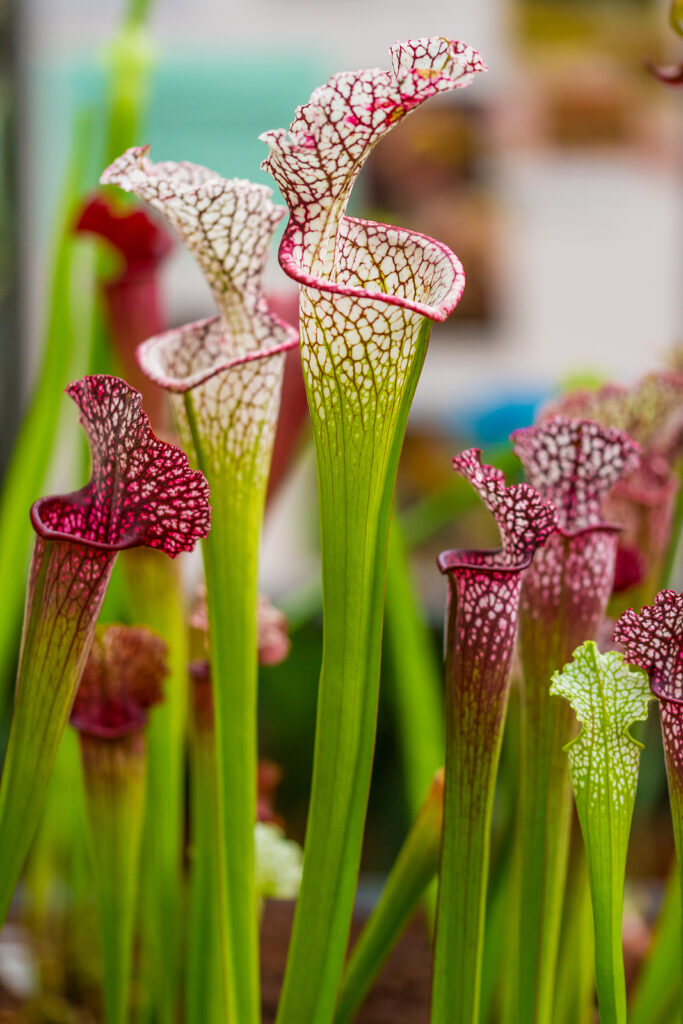Sarracenia–commonly called pitcher plant–is a carnivorous perennial native to bogs from Canada to Florida. Sarracenia grows from 6 to 36 inches tall from underground stems. Leaves form hollow tubes with short soft hairs on the edges and may be green, purple, or flushed with yellow.
The lips of Sarracenia leaves secrete a nectar that attracts insects; insects fall into a watery pool a the bottom of the leaf and are digested by the plant. Sarracenia bloom in spring or summer and are greenish-purple to wine red, umbrella-like, and slightly dropping.
Sarracenia can be grown indoors. Plants should be kept wet by standing in a tray of acidic water. Outdoors it can be grown in a damp, shaded peat bed or bog garden.
Sarracenia is a genus of 8 species of evergreen perennials native to bogs from Canada to Florida.
Get to know Sarracenia
- Plant type: Carnivorous perennial
- Growing zones and range: Zones 7-10
- Hardiness: Half-hardy, keep indoors where temperatures fall below 23°F (-5°C)
- Temperature: a cool temperature, high humidity and a constantly moist growing medium; it does best in a terrarium.
- Height and width: 4 to 36 inches (10-91cm) tall, 3 feet (1m) wide depending on the variety.
- Foliage: Short, thick rhizomes produce wiry roots, rosettes of phyllodies; some phyllodies change into nectar-secretingm insect-catching pitchers; pitchers are mostly vertical 2 to 36 inches tall with lateral wings and hooded lids.
- Flowers: Nodding or pendent more or less cup-shaped flowers with 4 or 5 sepals and 5 petals above the pitcher; flowers are greenish purple to wine red, umbrella-like and slightly drooping.
- Bloom time: Bloom in spring or summer.
- Uses: Peat or bog garden, houseplant
- Common name: Pitcher plant
- Botanical name: Sarracenia
- Family name: Sarraceniaceae
- Origin: Bogs from Canada to Florida

Where to plant Sarracenia
- Light outdoors: Grow Sarracenia in full sun outdoors.
- Light indoors: Sarracenia needs bright to direct light indoors.
- Soil outdoors: Grow Sarracenia in humus-rich, wet, acidic soil.
- Soil indoors: 3 parts sphagnum moss and 1 part each leaf mold and coarse sand or grit
When to plant Sarracenia
- Set Sarracenia outdoors in spring.
Planting and spacing Sarracenia
- Space Sarracenia 3 feet (1m) apart.
How to water and feed Sarracenia
- Water: Sarracenia needs a constantly moist growing medium; it does best in a terrarium. Sphagnum moss should be used for planting medium.
- Feeding: Sarracenia should be fertilized once or twice a month during spring and summer. Use a balanced liquid fertilizer.
Sarracenia care
- Sarracenia grows best indoors in a terrarium.
- Water Sarracenia often when growing indoors.
Growing Sarracenia as a houseplant
- Sarracenia needs bright to direct light, a cool temperature, high humidity, and a constantly moist growing medium; it will grow well in a terrarium.
- Sphagnum moss should be used as a planting medium.
- If Sarracenia does not catch insects, it should be fertilized once a week during spring and summer.
Sarracenia pests and diseases
- Sarracenia is susceptible to attack by scale insects, mealybugs, aphids, and tortrix moth caterpillars.
Sarracenia propagation
- Sarracenia can be propagated by division of its rhizomes and from seed.
Sarracenia varieties to grow
- Sarracenia flava, yellow pitcher plant. Bears erect yellow-green pitchers, 12 to 36 inches long with round mouths and raised lids veinted red.
- S. leucophylla, white trumpet pitcher plant. Erect, slender pitchers 10 to 39 inches long with narrow wings; lids are typically white; bears purpe flowers in spring.
- S. purpurea, common pitcher plant. Grows to 6 inches tall; pitchers are green and flushed with brownish purpl; leaf edges and veins are red.















